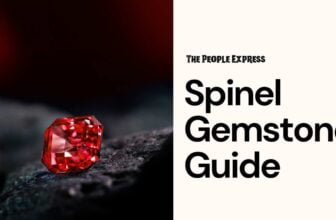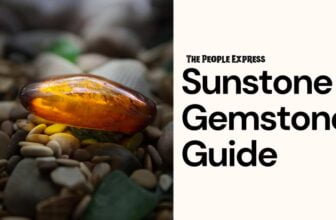The color grey (or gray) is not commonly associated with jewellery. Grey is an uncommon color in the world of gemstones, with only very few gemstones that are primarily grey in color. However, because of this very rarity in use in jewellery, grey gemstones are actually very intriguing when worn. While they may not jump out at you with the intensity of say, a red gemstone, grey gemstones have a subdued beauty. Grey Gemstones Guide
Grey Gemstones Guide
Grey is a neutral color that goes well with other colors. It is the perfect combination of black and white and represents balance, sophistication and compromise, but it also symbolizes emotionlessness, loss or moodiness.
Here is a list of the top 8 grey (gray) gemstones that are used in jewellery.
Grey Diamonds

There is such a thing as a grey diamond although it is not widely known. The diamond gets its grey hue from the inclusion of hydrogen in its composition. The range of color in grey diamonds is quite wide and varies from Faint Grey to Fancy Dark Grey. In the diamond industry, these shades are given nicknames such as charcoal grey, pigeon and silver, to identify the color.
The beauty of a grey diamond is that it is not as traditional as colorless diamonds nor as radical as black diamonds. It has just the right touch of mystery and irregularity. Grey diamonds are also relatively affordable compared to most other colored diamonds. With its exceptional durability (10 Mohs), these diamonds are perfect for a non-conventional piece of jewellery.
Grey Moonstone

Moonstone is probably the most famous grey gemstone. Grey moonstone is commonly translucent and ranges in color from colorless to dark grey. The moonstone is not a very durable stone (6 to 6.5 Mohs) and is suitable for pendants, earrings, bracelets, hair combs and other types of jewellery that are more protected.
Moonstone rings aren’t recommended due to the stone’s relatively softness, however, if taken reasonable care of, they can last a long time. They are often cut cabochon to enhance the luster and smooth sheen of the stone although sometimes they may be faceted. Raw unpolished grey moonstone has an eye-catching rustic simplicity that is beautiful when set into well-crafted jewellery.
Grey Agate
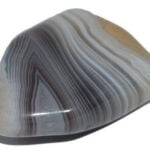
Agate is an abundantly found gemstone that comes in all colors imaginable. Grey agate can be found with a unicolor appearance or banded with layers of white. Agate is often translucent, which makes it ideal for cabochons.
Grey agate has a smooth, beautiful sheen and a waxy to vitreous luster and because of its affordability, is an excellent gemstone for all types of jewellery, particularly large costume pieces. Agate has good durability (Mohs 7) and can last many decades.
Mother of Pearl
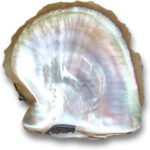
Mother-of-pearl is an organic gemstone, that is made of the same substance as pearls but is quite different in its formation. It refers to the layer of nacre that coats the inner shell and is iridescent in appearance.
This common gemstone comes from pearl-producing mollusks and occurs in a range of colors. Mother-of-pearl is opaque to translucent in appearance and has a pearly luster. It is abundantly found and therefore very affordable.
Like all organic gemstones, mother-of-pearl is soft (2.5 to 4.5 Moh) and can easily get damaged or scratched. It is perfect for carvings and for inlay jewellery, as well as pendants and earrings, but not so much for rings. Because of its iridescence, it is especially beautiful when seen under lights in jewellery that allows for movement. This enhances its sparkle and exhibits the colors that flash from the gemstone.
Grey Pearl

Pearls are traditionally white, but they come in an array of colors. Grey pearls are an ideal break from tradition while still exhibiting the luster and sophisticated look that pearls are famous for.
Gemstone in Grey pearls come in a range of hues, from a faint dusty grey to a darker, metallic gunmetal grey. Grey pearls in nature are very rare and would require very stringent conditions to be formed in.
Most grey pearls on the market are cultured and often enhanced. Like all organic gemstones, grey pearls are very soft, ranking at only 2.5 on the Mohs scale. They are easily abraded and can break or chip if subject to heavy pressure. They are not ideal to be worn in every day jewellery and requires proper care and maintenance to keep them lustrous and protected.
Grey Labradorite

Labradorite is often grey or grey-black but due to its iridescence, it often appears very colorful and dynamic. This iridescence is known as labradorescence – a flashy display of color that occurs in opaque varieties of labradorite. Transparent labradorites are beautiful but they don’t display this iridescent and aren’t as valuable as the opaque varieties. Most grey labradorite will have this desirable labradorescence due to the dark body tone.
Labradorite is a plagioclase feldspar, among the most common and abundantly found minerals. It is not a very hard gemstone (6 to 6.5 Mohs) but due to its compact structure, it is a tough stone. Labradorite is used in all types of jewellery but is especially beautiful when set in bohemian and gypsy styles.
Grey Chalcedony
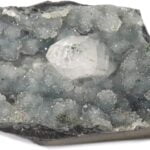
Chalcedony is an abundantly found gemstone. The grey variety is quite common and is relatively affordable. It translucent to opaque with a waxy luster. Chalcedony is a very tough stone as it has a microcrystalline structure.
What this means is that the gemstone does not contain any crystal formations within it but is instead smooth, compact and tough. What’s more, it also has no cleavage which refers to a gemstone’s tendency to break, and has a hardness ranking of 6.5 to 7 Mohs. Grey chalcedony can be made into all types of jewellery.
Grey Tourmaline
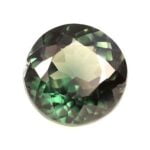
Tourmaline is an abundantly found gemstone making it reasonably priced in use in jewellery. While grey is not its most popular color, grey tourmaline makes for stunning jewellery due to its sparkle and transparency.
Grey tourmaline has a vitreous luster and is often faceted to enhance its brilliance. Tourmalines are durable gemstones (Mohs 7 to 7.5) and are also resistant to breakage. Grey tourmaline is often free of visible inclusions and have very good clarity. Grey tourmalines can be cut into traditional gemstone shapes such as the emerald cut, pear, marquise and brilliant shapes and other unique fancy cuts.
Some Other Grey Gemstones
- Fluorite– This is a brilliant gemstone with a beautiful grey hue. However, it is quite rare and soft, making it unsuitable for most jewellery making.
- Hematite– This gemstone occurs in black to steel-grey colors. While not highly durable, hematite is a very brilliant gemstone.
- Grey Sapphire– This is a unique color for sapphire but like all sapphires, the grey variety is also highly durable and makes a very good choice for jewellery.
- Spinel– Grey spinel displays beautiful grey-silver hues and has very good brilliance and durability.
Table of Contents
Toggle



